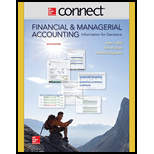
Concept explainers
Debit Entries:
Debit entries are those entries that are made when the value of an asset increases or the expenses are paid by company. On these occasions, the particular account is debited.
Credit Entries:
Credit entries are those entries which happen to increase a liability. On these occasions, the particular account is credited. All the incomes and gains generated by the company are also credited.
Worksheet:
A worksheet is a form of a spreadsheet which is used by the accountants or book keepers to record the data and organize it. All the accounting data is prepared in a worksheet because it reduces the chances of forgetting an adjustment.
To explain: Reason for the debit and credit entries in the adjustments columns of the worksheet identified with letters.
Want to see the full answer?
Check out a sample textbook solution
Chapter 3 Solutions
Connect 2 Semester Access Card for Financial and Managerial Accounting
- Give true answer this general accounting questionarrow_forwardAmy is evaluating the cash flow consequences of organizing her business entity SHO as an LLC (taxed as a sole proprietorship), an S corporation, or a C corporation. She used the following assumptions to make her calculations: a) For all entity types, the business reports $22,000 of business income before deducting compensation paid to Amy and payroll taxes SHO pays on Amy's behalf. b) All entities use the cash method of accounting. c) If Amy organizes SHO as an S corporation or a C corporation, SHO will pay Amy a $5,000 annual salary (assume the salary is reasonable for purposes of this problem). For both the S and C corporations, Amy will pay 7.65 percent FICA tax on her salary and SHO will also pay 7.65 percent FICA tax on Amy's salary (the FICA tax paid by the entity is deductible by the entity). d) Amy's marginal ordinary income tax rate is 35 percent, and her income tax rate on qualified dividends and net capital gains is 15 percent. e) Amy's marginal self-employment tax rate is…arrow_forwardInformation pertaining to Noskey Corporation’s sales revenue follows: November 20X1 (Actual) December 20X1 (Budgeted) January 20X2 (Budgeted)Cash sales $ 115,000 $ 121,000 $ 74,000Credit sales 282,000 409,000 208,000Total sales $ 397,000 $ 530,000 $ 282,000Management estimates 5% of credit sales to be uncollectible. Of collectible credit sales, 60% is collected in the month of sale and the remainder in the month following the month of sale. Purchases of inventory each month include 70% of the next month’s projected total sales (stated at cost) plus 30% of projected sales for the current month (stated at cost). All inventory purchases are on account; 25% is paid in the month of purchase, and the remainder is paid in…arrow_forward
- Mirror Image Distribution Company expects its September sales to be 20% higher than its August sales of $163,000. Purchases were $113,000 in August and are expected to be $133,000 in September. All sales are on credit and are expected to be collected as follows: 40% in the month of the sale and 60% in the following month. Purchases are paid 20% in the month of purchase and 80% in the following month. The cash balance on September 1 is $23,000. The ending cash balance on September 30 is estimated to be:arrow_forwardBalance sheet information is useful for all of the following except:a) evaluating a company's financial flexibilityb) evaluating a company's liquidityc) assesing a company's riskd) determining free cash flowsarrow_forwardNonearrow_forward

 AccountingAccountingISBN:9781337272094Author:WARREN, Carl S., Reeve, James M., Duchac, Jonathan E.Publisher:Cengage Learning,
AccountingAccountingISBN:9781337272094Author:WARREN, Carl S., Reeve, James M., Duchac, Jonathan E.Publisher:Cengage Learning, Accounting Information SystemsAccountingISBN:9781337619202Author:Hall, James A.Publisher:Cengage Learning,
Accounting Information SystemsAccountingISBN:9781337619202Author:Hall, James A.Publisher:Cengage Learning, Horngren's Cost Accounting: A Managerial Emphasis...AccountingISBN:9780134475585Author:Srikant M. Datar, Madhav V. RajanPublisher:PEARSON
Horngren's Cost Accounting: A Managerial Emphasis...AccountingISBN:9780134475585Author:Srikant M. Datar, Madhav V. RajanPublisher:PEARSON Intermediate AccountingAccountingISBN:9781259722660Author:J. David Spiceland, Mark W. Nelson, Wayne M ThomasPublisher:McGraw-Hill Education
Intermediate AccountingAccountingISBN:9781259722660Author:J. David Spiceland, Mark W. Nelson, Wayne M ThomasPublisher:McGraw-Hill Education Financial and Managerial AccountingAccountingISBN:9781259726705Author:John J Wild, Ken W. Shaw, Barbara Chiappetta Fundamental Accounting PrinciplesPublisher:McGraw-Hill Education
Financial and Managerial AccountingAccountingISBN:9781259726705Author:John J Wild, Ken W. Shaw, Barbara Chiappetta Fundamental Accounting PrinciplesPublisher:McGraw-Hill Education





